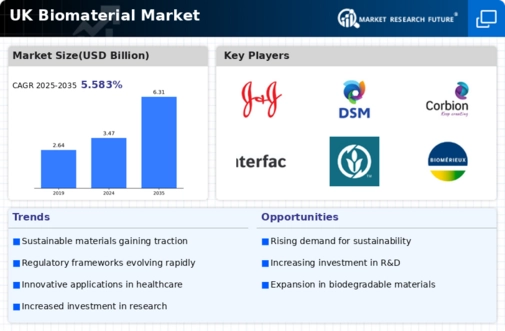The UK Biomaterial Market is characterized by a dynamic competitive landscape driven by innovations in medical devices, tissue engineering, and regenerative medicine. As healthcare standards continue to rise, there is a growing emphasis on biocompatibility, functionality, and sustainability of materials used in medical applications. This market has witnessed an influx of companies leveraging advanced technologies and research to develop new materials and applications. The competitive insights reveal a focus on collaboration, strategic alliances, and significant investments in research and development, allowing firms to gain an edge in this rapidly evolving field.
Companies are not just competing on product quality but also on their ability to adapt to regulatory changes and shifting consumer needs, which has shaped the market considerably.
Johnson & Johnson holds a prominent position in the UK Biomaterial Market, leveraging its extensive portfolio of medical devices and products that incorporate biomaterials. The company's strengths lie in its robust research capabilities and strong brand reputation, which have enabled it to maintain a significant market presence in the UK. Johnson & Johnson is known for its commitment to innovation and quality, fostering trust among healthcare providers and patients alike. The company's ability to navigate regulatory requirements efficiently further enhances its competitiveness, as it ensures timely product approvals and market introductions.
Additionally, its strategic partnerships with various healthcare institutions and organizations bolster its influence and outreach within the biomechanical and biocompatible materials sectors, allowing the company to respond effectively to market demands.
Royal DSM has established itself as a key player in the UK Biomaterial Market, focusing on sustainable and innovative biomaterials that cater to a variety of healthcare applications. The company offers a range of key products and services, including biopolymers and bio-resorbable materials, which are crucial in medical devices and tissue engineering. Royal DSM has a strong market presence, driven by its commitment to sustainability and reducing the environmental impact of its products. The company's strengths lie in its collaborative approach, often engaging in strategic mergers and acquisitions to enhance its technological capabilities and market reach.
Through partnerships with research institutions and other stakeholders, Royal DSM has made significant strides in advancing biomaterial research in the UK. Their emphasis on innovation and sustainability positions them advantageously in a market progressively leaning towards eco-friendly solutions, thereby ensuring they remain competitive and relevant in an evolving healthcare landscape.


















